Examining Land Use/Land Cover Change and Its Prediction Based on a Multilayer Perceptron Markov Approach in the Luki Biosphere Reserve, Democratic Republic of Congo
Abstract
1. Introduction
2. Materials and Methods
2.1. Study Area
2.2. Image Classification and Accuracy Assessment
2.3. MLPNN_Markov Chain Model for LUC Change Prediction
2.3.1. MLP Neural Network Model
2.3.2. Markov Chain Analysis
2.3.3. Implementation of the MLPNN_Markov Modeling
2.3.4. Variables Selection
2.3.5. Model Validation
2.4. Gradient Direction Analysis
2.5. Landscape Metrics Analysis
3. Results
3.1. Land Use/Land Cover Change of the Luki Biosphere Reserve
3.2. Transition among Land Use/Land Cover Types from 1987 to 2038
3.3. Land Use/Land Cover Change at Different Zonal Levels of the Luki Biosphere Zone
3.4. Landscape Metrics Analysis at the Luki Biosphere Reserve
3.5. Impact of Village Expansion on Land Use/Land Cover Change
4. Discussion
4.1. Land Use Change of the Luki Biosphere Reserve
4.2. Prediction of Land Use/Land Cover Change
5. Conclusions
Author Contributions
Funding
Institutional Review Board Statement
Informed Consent Statement
Data Availability Statement
Acknowledgments
Conflicts of Interest
References
- Han, H.; Yang, C.; Song, J. Scenario Simulation and the Prediction of Land Use and Land Cover Change in Beijing China. Sustainability 2015, 7, 4260–4279. [Google Scholar] [CrossRef]
- Rawat, J.S.; Kumar, M. Monitoring land use/cover change using remote sensing and GIS techniques: A case study of Hawalbagh block, district Almora, Uttarakhand, India. Egypt. J. Remote Sens. Space Sci. 2015, 18, 77–84. [Google Scholar] [CrossRef]
- McConnell, W.J. Land Change: The Merger of Land Cover and Land use Dynamics. In International Encyclopedia of the Social & Behavioral Sciences, 2nd ed.; Elsevier: Oxford, UK, 2015; pp. 220–223. [Google Scholar]
- Lambin, E. Land Cover Assessment and Monitoring. In Encyclopedia of Analytical Chemistry; John Wiley & Sons, Ltd.: Hoboken, NJ, USA, 2006. [Google Scholar] [CrossRef]
- Hyandye, C.; Martz, L.W. A Markovian and cellular automata land-use change predictive model of the Usangu Catchment. Int. J. Remote Sens. 2016, 38, 64–81. [Google Scholar] [CrossRef]
- Galicia, L.; Garcia-Romero, A. Land use and land cover change in highland temperate forests in the Izta-Popo National Park, central Mexico. Mt. Res. Dev. 2007, 27, 48–57. [Google Scholar] [CrossRef]
- Fox, J.; Vogler, J.B. Land-use and land-cover change in montane mainland Southeast Asia. Environ. Manag. 2005, 36, 394–403. [Google Scholar] [CrossRef]
- Ouedraogo, I.; Tigabu, M.; Savadogo, P.; Compaoré, H.; Odén, P.C.; Ouadba, J.M. Land cover change and its relation with population dynamics in Burkina Faso, West Africa. Land Degrad. Dev. 2010, 21, 453–462. [Google Scholar] [CrossRef]
- Ernst, C.; Verhegghen, A.; Mayaux, P.; Hansen, M.; Defourny, P. Cartographie du couvert forestier et des changements du couvert forestier en Afrique centrale. In Les Forets du Bassin du Congo—Etat des Forets 2010; De Wasseige, C., De Marcken, P., Bayol, N., Hiol Hiol, F., Mayaux, P., Desclee, B., Billand, A., Nasi., R., Eds.; Office des Publications de l’Union Europeenne: Luxembourg, 2012; pp. 23–42. [Google Scholar] [CrossRef]
- Devers, D.; Van de Weghe, J.P. (Eds.) Les Forêts du Bassin du Congo. État des forêts 2006. Partenariat pour les forêts du Bassin du Congo; United States Agency for International Development: Washington, DC, USA, 2007; 256p. Available online: http://carpe.umd.edu/Documents/2006/LES_FORETS_DU_BASSIN_DU_CONGO_Etat_des_Forets_2006.pdf (accessed on 8 May 2021).
- Gillet, P.; Vermeulen, C.; Feintrenie, L.; Dessard, H.; Garcia, C. Quelles sont les causes de la deforestation dans le bassin du Congo? Synthese bibliographique et etudes de cas. BASE 2016, 20, 183–194. [Google Scholar]
- Potapov, P.V.; Turubanova, S.V.; Hansen, M.C.; Adusei, B.; Broich, M.; Altstatt, A.; Mane, L.; Justice, C.O. Quantifying forest cover loss in Democratic Republic of the Congo, 2000–2010, with Landsat ETM+ data. Remote Sens. Environ. 2012, 122, 106–116. [Google Scholar] [CrossRef]
- Duveiller, G.; Defourny, P.; Desclee, B.; Mayaux, P. Deforestation in Central Africa: Estimates at regional, national and landscape levels by advanced processing of systematically- distributed Landsat extracts. Remote Sens. Environ. 2008, 112, 1969–1981. [Google Scholar] [CrossRef]
- Muyaya, K.B.; Rudant, J.P.; Lumbuenamo, R.; Beland, M.; Riera, B. Dynamique spatiale du domaine de chasse et reserve de Bombo Lumene entre 2000 et 2015 par imagerie satellitaire optique. Int. J. Innov. Appl. Stud. 2016, 2, 559–568. [Google Scholar]
- De Wasseige, C.; de Marcken, P.; Bayol, N.; Hiol, F.; Mayaux, P.; Desclee, B.; Billand, A.; Nasi, R. Les Forets du Bassin du Congo –Etat des Forets 2010; Office des publications de l’Union europeenne: Luxembourg, 2012; 276p. [Google Scholar]
- Molinario, G.; Hansen, M.C.; Potapov, P.V. Forest cover dynamics of shifting cultivation in the Democratic Republic of Congo: A remote sensing-based assessment for 2000–2010. Environ. Res. Lett. 2015, 10. [Google Scholar] [CrossRef]
- Pendje, G.; Mbaya, M. La réserve de Biosphère de Luki, Patrimoine Floristique et Faunique en Péril; UNESCO: Paris, France, 1992; 62p. [Google Scholar]
- Doumenge, C. La Conservation des Écosystèmes Forestiers du Zaïre; UICN: Gland, Switzerland, 1990; p. 242. [Google Scholar]
- Gata, D. Etudes des Impacts Humains, Estimation De Degré de Péril de la Biodiversité et Principes Directeurs pour une Gestion Durable des Ressources Disponibles; MAB: Kinshasa, Democratic Republic of the Congo, 1997; 37p. [Google Scholar]
- Nyange, N.M. Participation des communautés locales et gestion durable des forêts: Cas de la réserve de la biosphère de Luki en République Démocratique du Congo. Ph.D. Thesis, Université Laval Québec, Québec, QC, Canada, 2014; 227p. Available online: https://corpus.ulaval.ca/jspui/bitstream/20.500.11794/25349/1/30892.pdf (accessed on 2 May 2021).
- Cromley, R.; Hanink, D. Coupling land use allocation models with raster GIS. J. Geograph. Syst. 1999, 1, 137–153. [Google Scholar] [CrossRef]
- Sahebgharani, A. Multi-objective land use optimization through parallel particle swarm algorithm: Case study Baboldasht district of Isfahan, Iran. J. Urban Environ. Eng. 2016, 10, 42–49. [Google Scholar] [CrossRef]
- Opelele, O.M.; Fan, W.Y.; Yu, Y.; Kachaka, S.K. Analysis of land use/land cover change and its prediction in the mambasa sector, democratic republic of Congo. Appl. Ecol. Environ. Res. 2020, 18, 5627–5644. [Google Scholar] [CrossRef]
- Abdulrahman, A.I.; Ameen, S.A. Predicting Land use and land cover spatiotemporal changes utilizing CA-Markov model in Duhok district between 1999 and 2033. Acad. J. Nawroz Univ. 2020, 9, 71–80. [Google Scholar] [CrossRef]
- Mondal, B.; Das, D.N.; Bhatta, B. Integrating cellular automata and Markov techniques to generate urban development potential surface: A study on Kolkata agglomeration. Geocarto Int. 2017, 32, 401–419. [Google Scholar] [CrossRef]
- QuanLi, X.; Kun, Y.; GuiLin, W.; YuLian, Y. Agent-based modeling and simulations of land-use and land-cover change according to ant colony optimization: A case study of the Erhai Lake Basin, China. Nat. Hazards 2015, 75, 95–118. [Google Scholar] [CrossRef]
- Mishra, V.N.; Rai, P.K. A remote sensing aided multilayer perceptron-Markov chain analysis for land use and land cover change prediction in Patna district (Bihar), India. Arab. J. Geosci. 2016, 9. [Google Scholar] [CrossRef]
- Balzter, H. Markov chain models for vegetation dynamics. Ecol. Modell. 2000, 126, 139–154. [Google Scholar] [CrossRef]
- Mishra, V.N.; Rai, P.K.; Prasad, R.; Punia, M.; Nistor, M.M. Prediction of spatio-temporal land use/land cover dynamics in rapidly developing Varanasi district of Uttar Pradesh, India, using geospatial approach: A comparison of hybrid models. Appl. Geomat. 2018, 10, 257–276. [Google Scholar] [CrossRef]
- Feng, Y.; Liu, Y. A heuristic cellular automata approach for modelling urban land-use change based on simulated annealing. Int. J. Geogr. Inf. Sci. 2012, 27, 449–466. [Google Scholar] [CrossRef]
- National Research Council. Advancing Land Change Modeling: Opportunities and Research Requirements; The National Academies Press: Washington, DC, USA, 2014; ISBN 978-0-309-28833-0. [Google Scholar]
- Ansari, A.; Golabi, M.H. Prediction of spatial land use changes based on LCM in a GIS environment for Desert Wetlands—A case study: Meighan Wetland, Iran. Int. Soil Water Conserv. Res. 2019, 7, 64–70. [Google Scholar] [CrossRef]
- Mozumder, C.; Tripathi, N.K. Geospatial scenario based modelling of urban and agricultural intrusions in Ramsar wetland deepor beel in northeast India using a multilayer perceptron neural network. Int. J. Appl. Earth Obs. Geoinf. 2014, 32, 92–104. [Google Scholar] [CrossRef]
- Bhatti, S.S.; Tripathi, N.K.; Nitivattananon, V.; Rana, I.A.; Mozumder, C. A multi-scale modeling approach for simulating urbanization in a metropolitan region. Habitat Int. 2015, 50, 354–365. [Google Scholar] [CrossRef]
- Shoyama, K.; Matsui, T.; Hashimoto, S.; Kabaya, K.; Oono, A.; Saito, O. Development of land-use scenarios using vegetation inventories in Japan. Sustain. Sci. 2019, 14, 39–52. [Google Scholar] [CrossRef]
- Ye, B.; Bai, Z. Simulating land use/cover changes of Nenjiang County based on CA-Markov model. Comput. Comput. Technol. Agric. 2008, 1, 321–329. [Google Scholar] [CrossRef]
- Pontius, G.R.; Malanson, J. Comparison of the structure and accuracy of two land change models. Int. J. Geogr. Inf. Sci. 2005, 19, 243–265. [Google Scholar] [CrossRef]
- Parsamehr, K.; Gholamalifard, M.; Kooch, Y. Comparing three transition potential modeling for identifying suitable sites for REDD+ projects. Spat. Inf. Res. 2020, 28, 159–171. [Google Scholar] [CrossRef]
- Muller, M.R.; Middleton, J. A Markov model of land-use change dynamics in the Niagara Region, Ontario, Canada. Landsc. Ecol. 1994, 9, 151–157. [Google Scholar] [CrossRef]
- Sinha, P.; Kimar, L. Markov land cover change modeling using pairs of time-series satellite images. Photogramm. Eng. Remote Sens. 2013, 79, 1037–1051. [Google Scholar] [CrossRef]
- Harris, I.; Osborn, T.J.; Jones, P.; Lister, D.H. Version 4 of the CRU TS monthly high-resolution gridded multivariate climate dataset. Sci. Data 2020, 7, 109. [Google Scholar] [CrossRef]
- Vadrevu, K.P. Introduction to Remote Sensing. In The Photogrammetric Record, 5th ed.; Campbell, J.B., Wynne, R.H., Eds.; Guilford Press: New York, NY, USA, 2013. [Google Scholar]
- Keshtkar, H.; Voigt, W.; Alizadeh, E. Land-cover classification and analysis of change using machine learning classifiers and multi-temporal remote sensing imagery. Arab. J. Geosci. 2017, 10. [Google Scholar] [CrossRef]
- Pijanowski, B.C.; Pithadia, S.; Shellito, B.A. Calibrating a neural network-based urban change model for two metropolitan areas of the Upper Midwest of the United States. Int. J. Geogr. Inf. Sci. 2005, 19, 197–215. [Google Scholar] [CrossRef]
- Congalton, R.G.; Mead, R.A. A quantitative method to test for consistency and correctness in photo-interpretation. Photogramm. Eng. Remote Sens. 1983, 49, 69–74. [Google Scholar]
- Ju, W.; Lam, N. Urban land use classification: Applying texture analysis and artificial intelligence. Imaging Notes 2007, 22, 26–30. [Google Scholar] [CrossRef]
- Li, X.; Yeh, A.G.O. Neural-network-based cellular automata for simulating multiple land use changes using GIS. Int. J. Geogr. Inf. Sci. 2002, 16, 323–343. [Google Scholar] [CrossRef]
- Okwuashi, O.; Isong, M.; Eyo, E.; Eyoh, A.; Nwanekezie, O.; Olayinka, D.N.; Udoudo, D.O.; Ofem, B. GIS Cellular automata using artificial neural network for land use change simulation of Lagos, Nigeria. J. Geogr. Geol. 2012, 4. [Google Scholar] [CrossRef]
- Mahajan, Y.; Venkatachalam, P. Neural network based cellular automata model for dynamic spatial modeling in GIS. In Computational Science and Its Applications—ICCSA 2009; Gervasi, O., Taniar, D., Murgante, B., Laganà, A., Mun, Y., Eds.; Springer: Berlin/Heidelberg, Germany, 2009; pp. 341–352. [Google Scholar]
- Civco, D.L. Artificial neural networks for land-cover classification and mapping. Int. J. Geogr. Inf. Syst. 1993, 7, 173–186. [Google Scholar] [CrossRef]
- Haykin, S. Redes Neurais; Bookman: Porto Alegre, Brazil, 2001; p. 900. [Google Scholar]
- Atkinson, P.M.; Tatnall, A.R.L. Introduction neural networks in remote sensing. Int. J. Remote Sens. 1997, 18, 699–709. [Google Scholar] [CrossRef]
- Eastman, J.R. IDRISI Taiga Guide to GIS and Image Processing; Manual Version 16.02; Clark Labs: Worcester, MA, USA, 2009. [Google Scholar]
- Karul, C.; Soyupak, S. A comparison between neural network based and multiple regression models for chlorophyll-a estimation. In Ecological Informatics; Recknagel, F., Ed.; Springer: Berlin, Germany, 2006; pp. 309–323. [Google Scholar] [CrossRef]
- Yang, J.; Su, J.; Chen, F.; Xie, P.; Ge, Q. A local land-use competition cellular automata model and its application. ISPRS Int. J. Geo-Inf. 2016, 5, 106. [Google Scholar] [CrossRef]
- Mishra, V.N.; Rai, P.K.; Mohan, K. Prediction of land use changes based on land change modeler (LCM) using remote sensing: A case study of Muzaffarpur (Bihar), India. J. Geogr. Inst. Jovan Cvijic SASA 2014, 64, 111–127. [Google Scholar] [CrossRef]
- Yousheng, W.; Xinxiao, Y.; Kangning, H.; Qingyun, L.; Yousong, Z.; Siming, S. Dynamic simulation of land use change in Jihe watershed based on CA-Markov model. Trans. Chin. Soc. Agric. Eng. 2011, 27, 330–336. [Google Scholar] [CrossRef]
- Ma, C.; Zhang, G.Y.; Zhang, X.C.; Zhao, Y.J.; Li, H.Y. Application of Markov model in wetland change dynamics in Tianjin Coastal Area, China. Procedia Environ. Sci. 2012, 13, 252–262. [Google Scholar] [CrossRef]
- Sang, L.; Zhang, C.; Yang, J.; Zhu, D.; Yun, W. Simulation of land use spatial pattern of towns and villages based on CA–Markov model. Math. Comput. Model 2011, 54, 938–943. [Google Scholar] [CrossRef]
- Kumar, S.; Radhakrishnan, N.; Mathew, S. Land use change modelling using a Markov model and remote sensing. Geomat. Nat. Hazards Risk 2014, 5, 145–156. [Google Scholar] [CrossRef]
- Cramér, H. Methods of estimation. In Mathematical Methods of Statistics, 19th ed.; Princeton University Press: Princeton, NJ, USA, 1999; Chapter 33; pp. 497–506. [Google Scholar]
- Hamdy, O.; Zhao, S.; Salheen, M.A.; Eid, Y.Y. Analyses the driving forces for urban growth by using IDRISI Selva Models Abouelreesh—Aswan as a Case Study. Int. J. Eng. Technol. 2017, 9, 226–232. [Google Scholar] [CrossRef]
- Valdivieso, F.O.; Sendra, J.B. Application of GIS and remote sensing techniques in generation of land use scenarios for hydrological modeling. J. Hydrol. 2010, 395, 256–263. [Google Scholar] [CrossRef]
- Liebertrau, A.M. Measures of Association; Sage Publications: Newbury Park, CA, USA, 1983; Quantitative. [Google Scholar]
- Islam, K.; Rahman, M.F.; Jashimuddin, M. Modeling land use change using cellular automata and artificial neural network: The case of Chunati Wildlife Sanctuary, Bangladesh. Ecol. Indic. 2018, 88, 439–453. [Google Scholar] [CrossRef]
- Brown, D.G.; Goovaerts, P.; Burnicki, A.; Li, M.Y. Stochastic simulation of land cover change using geostatistics and generalized additive models. Photogramm. Eng. Remote Sens. 2002, 68, 1051–1061. [Google Scholar]
- Badoe, D.A.; Miller, E.J. Transportation–land-use interaction: Empirical findings in North America, and their implications for modeling. Transp. Res. Part D Transp. Environ. 2000, 5, 235–263. [Google Scholar] [CrossRef]
- Pontius, R.G.; Millones, M. Death to Kappa: Birth of quantity disagreement and allocation disagreement for accuracy assessment. Int. J. Remote Sens. 2011, 32, 4407–4429. [Google Scholar] [CrossRef]
- Bayes, A.; Raquib, A. Modeling urban land cover growth dynamics using multioral satellite images: A case study of Dhaka, Bangladesh. ISPRS Int. J. Geo-Inf. 2012, 1, 3–31. [Google Scholar] [CrossRef]
- Cao, H.; Liu, J.; Fu, C.; Zhang, W.; Wang, G.; Yang, G.; Luo, L. Urban Expansion and Its Impact on the Land Use Pattern in Xishuangbanna since the Reform and Opening up of China. Remote Sens. 2017, 9, 137. [Google Scholar] [CrossRef]
- Ji, W.; Ma, J.; Twibell, R.W.; Underhill, K. Characterizing urban sprawl using multi-stage remote sensing images and landscape metrics. Comput. Environ. Urban Syst. 2006, 30, 861–879. [Google Scholar] [CrossRef]
- Seto, K.C.; Fragkias, M. Quantifying Spatiotemporal Patterns of Urban Land-use Change in Four Cities of China with Time Series Landscape Metrics. Landsc. Ecol. 2005, 20, 871–888. [Google Scholar] [CrossRef]
- Martin, J. LecoS—A python plugin for automated landscape ecology analysis. Ecol. Inform. 2016, 31, 18–21. [Google Scholar] [CrossRef]
- Sun, Y.; Zhao, S.Q.; Qu, W.Y. Quantifying spatiotemporal patterns of urban expansion in three capital cities in Northeast China over the past three decades using satellite data sets. Environ. Earth Sci. 2015, 73, 7221–7235. [Google Scholar] [CrossRef]
- Qi, Z.-F.; Ye, X.-Y.; Zhang, H.; Yu, Z.-L. Land fragmentation and variation of ecosystem services in the context of rapid urbanization: The case of Taizhou city, China. Stoch. Environ. Res. Risk Assess. 2013, 28, 843–855. [Google Scholar] [CrossRef]
- Ramachandra, T.V.; Aithal, B.H.; Sanna, D.D. Insights to urban dynamics through landscape spatial pattern analysis. Int. J. Appl. Earth Obs. Geoinf. 2012, 18, 329–343. [Google Scholar] [CrossRef]
- Liu, H.; Weng, Q. Landscape metrics for analysing urbanization-induced land use and land cover changes. Geocarto Int. 2013, 28, 582–593. [Google Scholar] [CrossRef]
- Su, S.; Jiang, Z.; Zhang, Q.; Zhang, Y. Transformation of agricultural landscapes under rapid urbanization: A threat to sustainability in Hang-Jia-Hu region, China. Appl. Geogr. 2011, 31, 439–449. [Google Scholar] [CrossRef]
- He, X.; Gao, Y.; Niu, J.; Zhao, Y. Landscape Pattern Changes under the Impacts of Urbanization in the Yellow River Wetland––King Zhengzhou as an example. Procedia Environ. Sci. 2011, 10, 2165–2169. [Google Scholar] [CrossRef]
- Wang, C.; Myint, S.W.; Fan, P.; Stuhlmacher, M.; Yang, J. The impact of urban expansion on the regional environment in Myanmar: A case study of two capital cities. Landsc. Ecol. 2018, 33, 765–782. [Google Scholar] [CrossRef]
- Arifwidodo, S.D.; Tanaka, T. The Characteristics of Urban Heat Island in Bangkok, Thailand. Procedia Soc. Behav. Sci. 2015, 195, 423–428. [Google Scholar] [CrossRef]
- Pakarnseree, R.; Chunkao, K.; Bualert, S. Physical characteristics of Bangkok and its urban heat island phenomenon. Build. Environ. 2018, 143, 561–569. [Google Scholar] [CrossRef]
- Ali, G.; Pumijumnong, N.; Cui, S. Valuation and validation of carbon sources and sinks through land cover/use change analysis: The case of Bangkok metropolitan area. Land Use Policy 2018, 70, 471–478. [Google Scholar] [CrossRef]
- Bamba, I. Anthropisation et dynamique spatio-temporelle de paysages forestiers en République démocratique du Congo. Available online: https://www.congoforum.be/Upldocs/Forets%20These_finale_IBAMBA.pdf (accessed on 7 May 2021).
- Ciza, S.K.; Mikwa, J.F.; Malekezi, A.C.; Gond, V.; Bosela, F.B. Identification des moteurs de déforestation dans la région d’Isangi, République démocratique du Congo. Bois Forets des Tropiques 2015, 324, 29–38. [Google Scholar] [CrossRef]
- Mpoyi, A.M.; Nyamwoga, F.B.; Kabamba, F.M.; Assembe-mvondo, S. Le Contexte de la REDD+ en République Démocratique du Congo Causes, Agents et Institutions; CIFOR: Bogor, Indonesia, 2013. [Google Scholar] [CrossRef]
- Ngabinzeke, J.S.; Linchant, J.; Quevauvillers, S.; Muhongya, J.M.K.; Lejeune, P.; Vermeulen, C. Cartographie de la dynamique de terroirs villageois à l’aide d’un drone dans les aires protégées de la République démocratique du Congo. Bois Forets des Tropiques 2016, 315, 21–28. [Google Scholar] [CrossRef]
- Ziegler, A.D.; Fox, J.M.; Xu, J. The rubber juggernaut. Science 2009, 324, 1024–1025. [Google Scholar] [CrossRef]
- Fu, Y.; Chen, J.; Guo, H.; Hu, H.; Chen, A.; Cui, J. Agrobiodiversity loss and livelihood vulnerability as a consequence of converting from subsistence farming systems to commercial plantation-dominated systems in Xishuangbanna, Yunnan, China: A household level analysis. Land Degrad. Dev. 2010, 21, 274–284. [Google Scholar] [CrossRef]
- Shrestha, M.K.; York, A.M.; Boone, C.G.; Zhang, S. Land fragmentation due to rapid urbanization in the Phoenix Metropolitan Area: Analyzing the spatiotemporal patterns and drivers. Appl. Geogr. 2012, 32, 522–531. [Google Scholar] [CrossRef]
- Munroe, D.K.; Croissant, C.; York, A.M. Land use policy and landscape fragmentation in an urbanizing region: Assessing the impact of zoning. Appl. Geogr. 2005, 25, 121–141. [Google Scholar] [CrossRef]
- Gkyer, E. Understanding Landscape Structure Using Landscape Metrics. Advances in Landscape Architecture; InTech: London, UK, 2013. [Google Scholar] [CrossRef]
- Stewart, A.B.; Sritongchuay, T.; Teartisup, P.; Kaewsomboon, S.; Bumrungsri, S. Habitat and landscape factors influence pollinators in a tropical megacity, Bangkok, Thailand. PeerJ 2018, 6, e5335. [Google Scholar] [CrossRef] [PubMed]
- Chaiyarat, R.; Wutthithai, O.; Punwong, P.; Taksintam, W. Relationships between urban parks and bird diversity in the Bangkok metropolitan area, Thailand. Urban Ecosyst. 2018, 22, 201–212. [Google Scholar] [CrossRef]
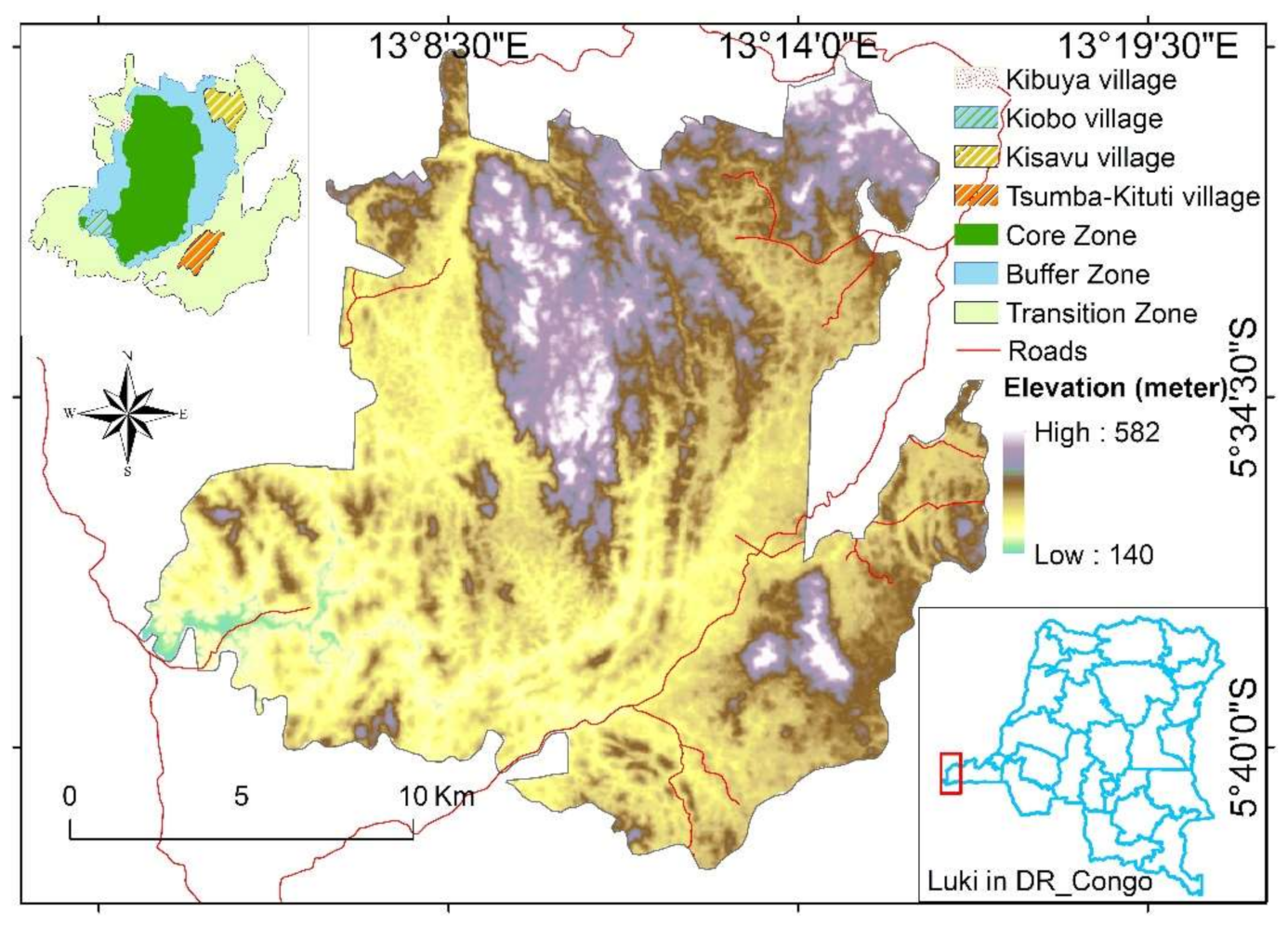
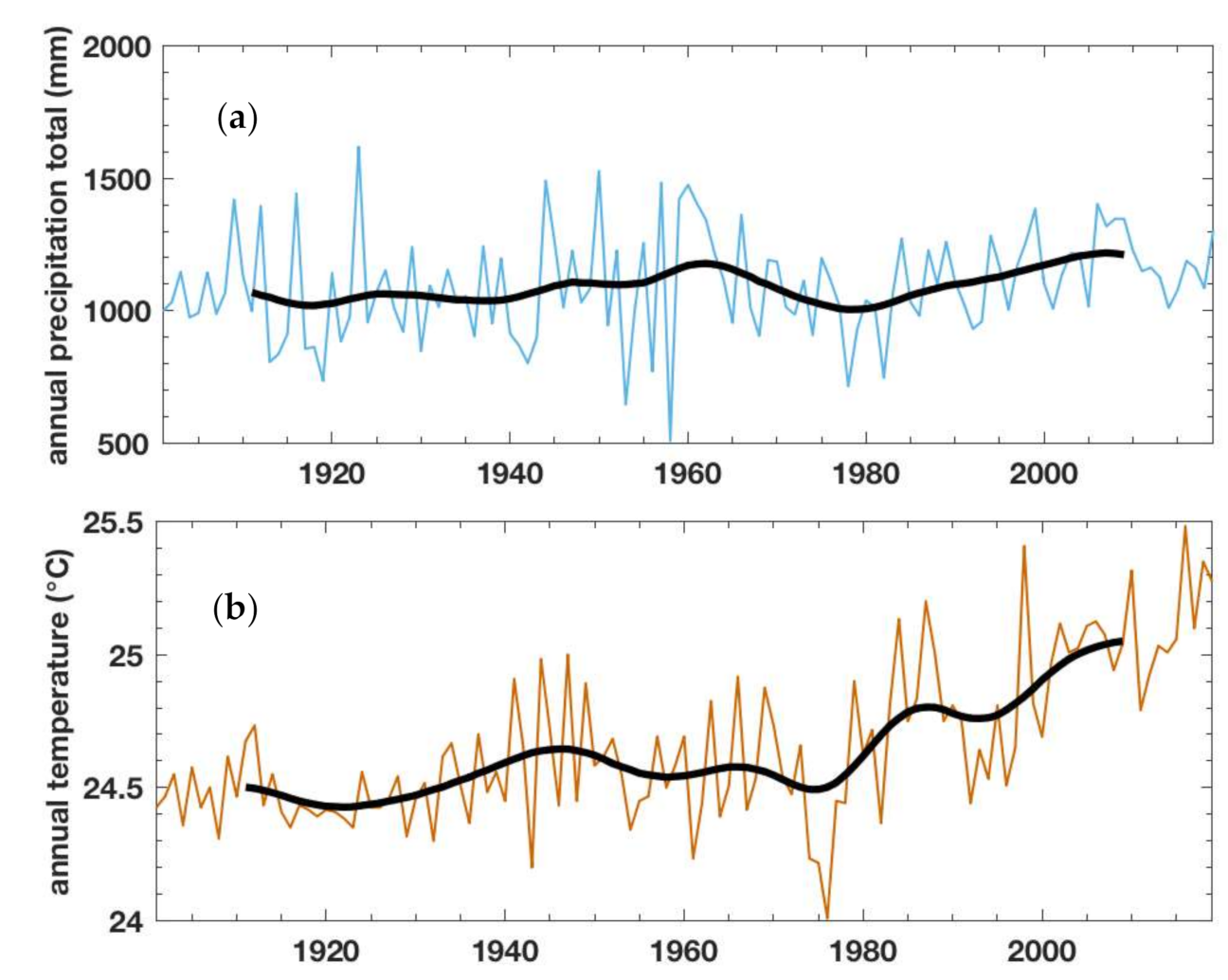
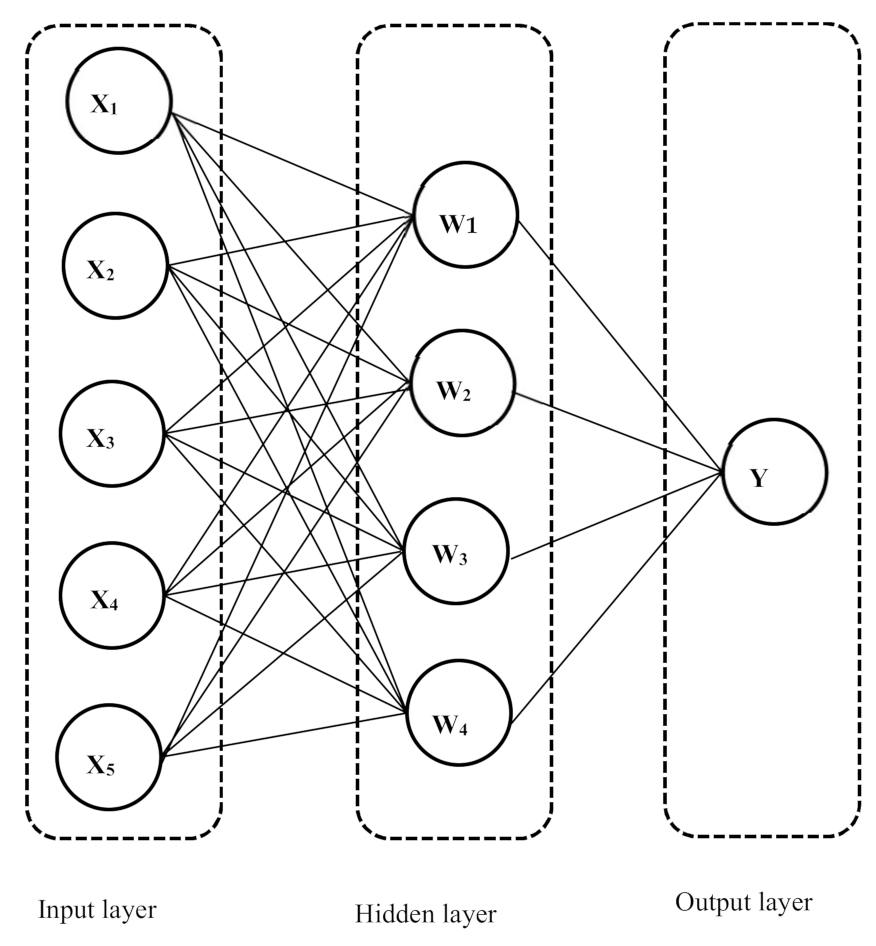
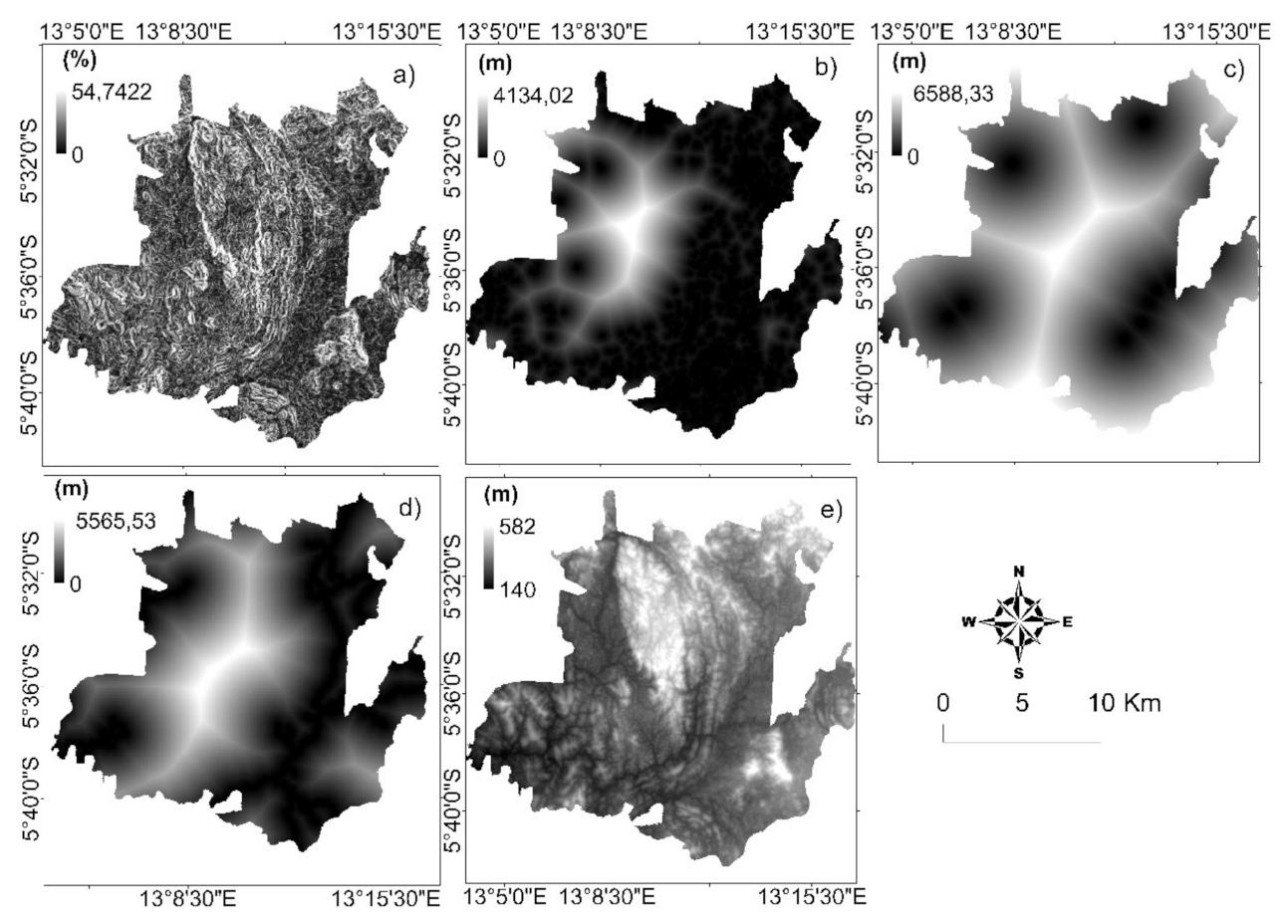
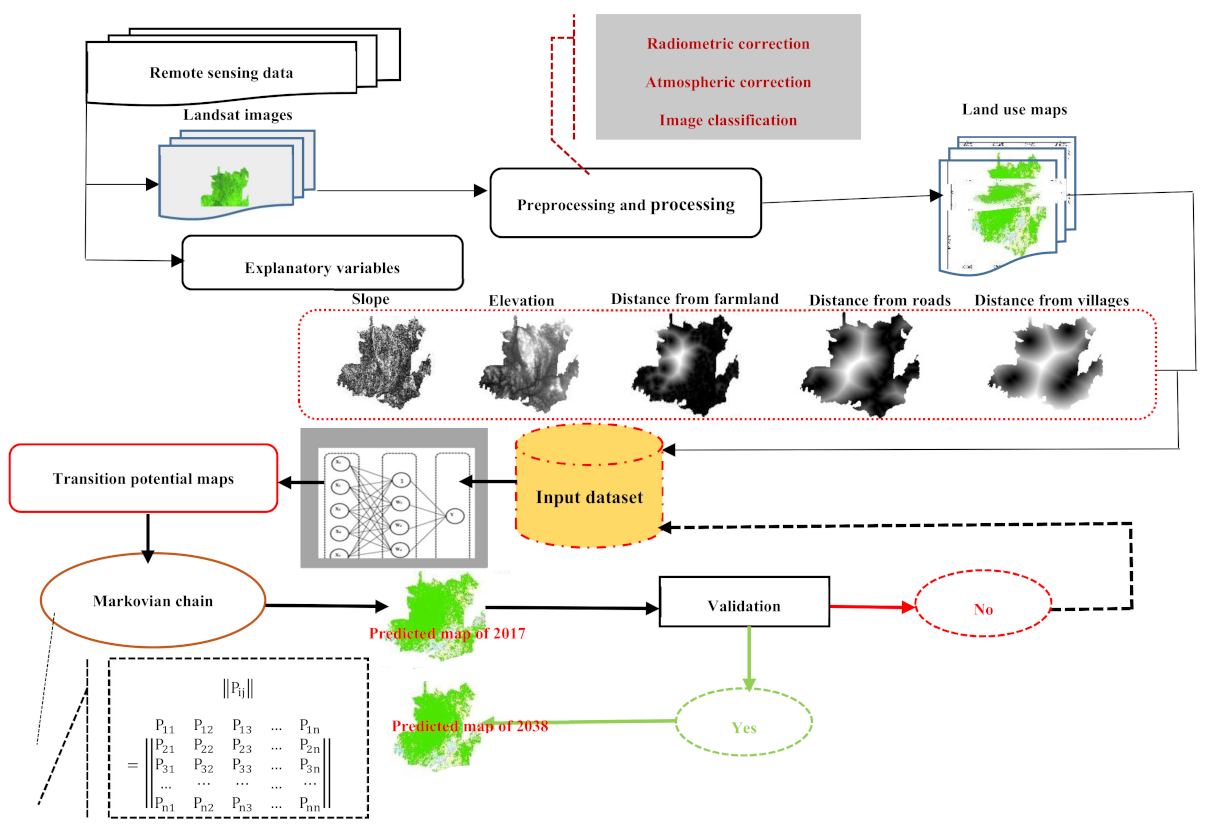
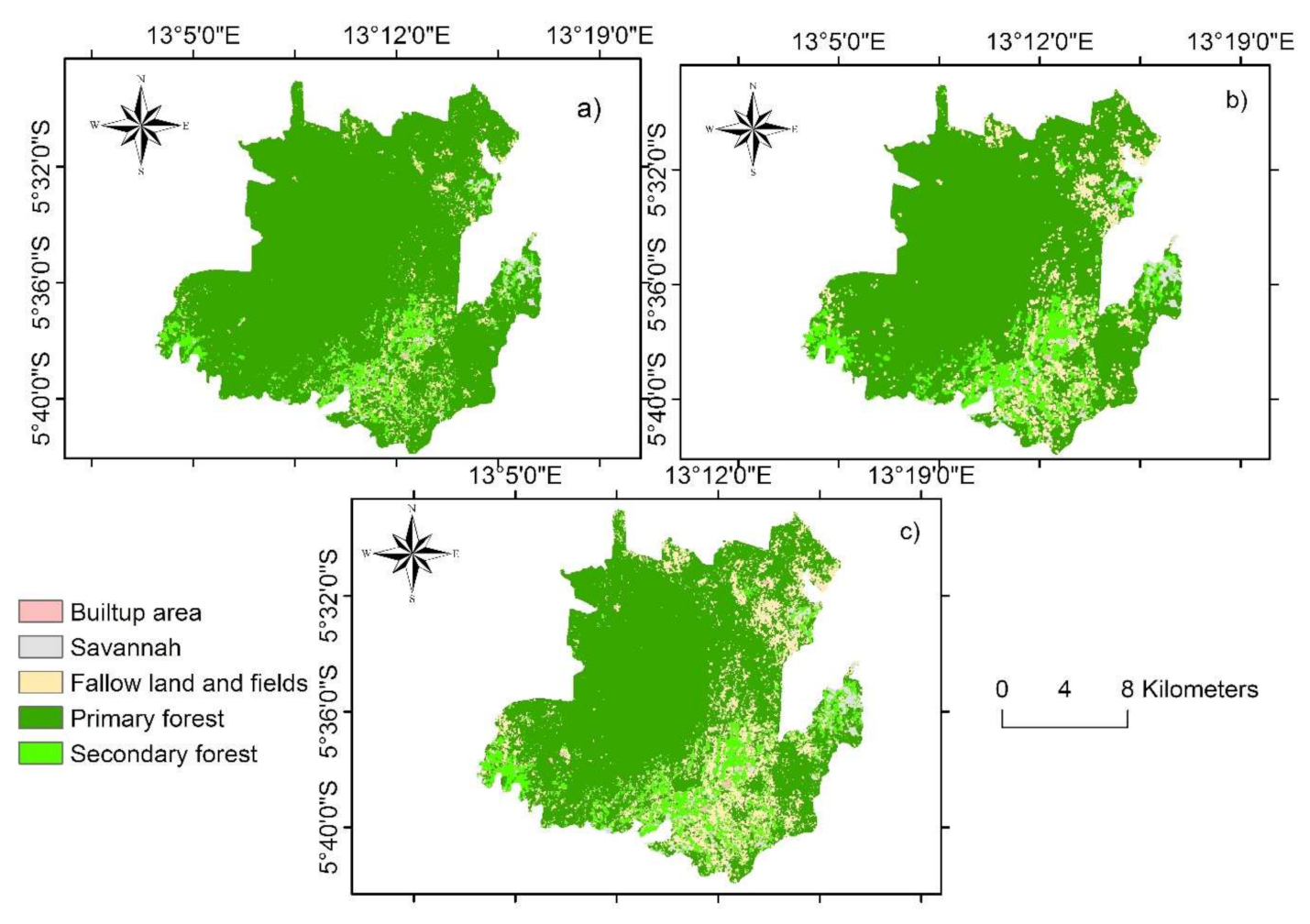
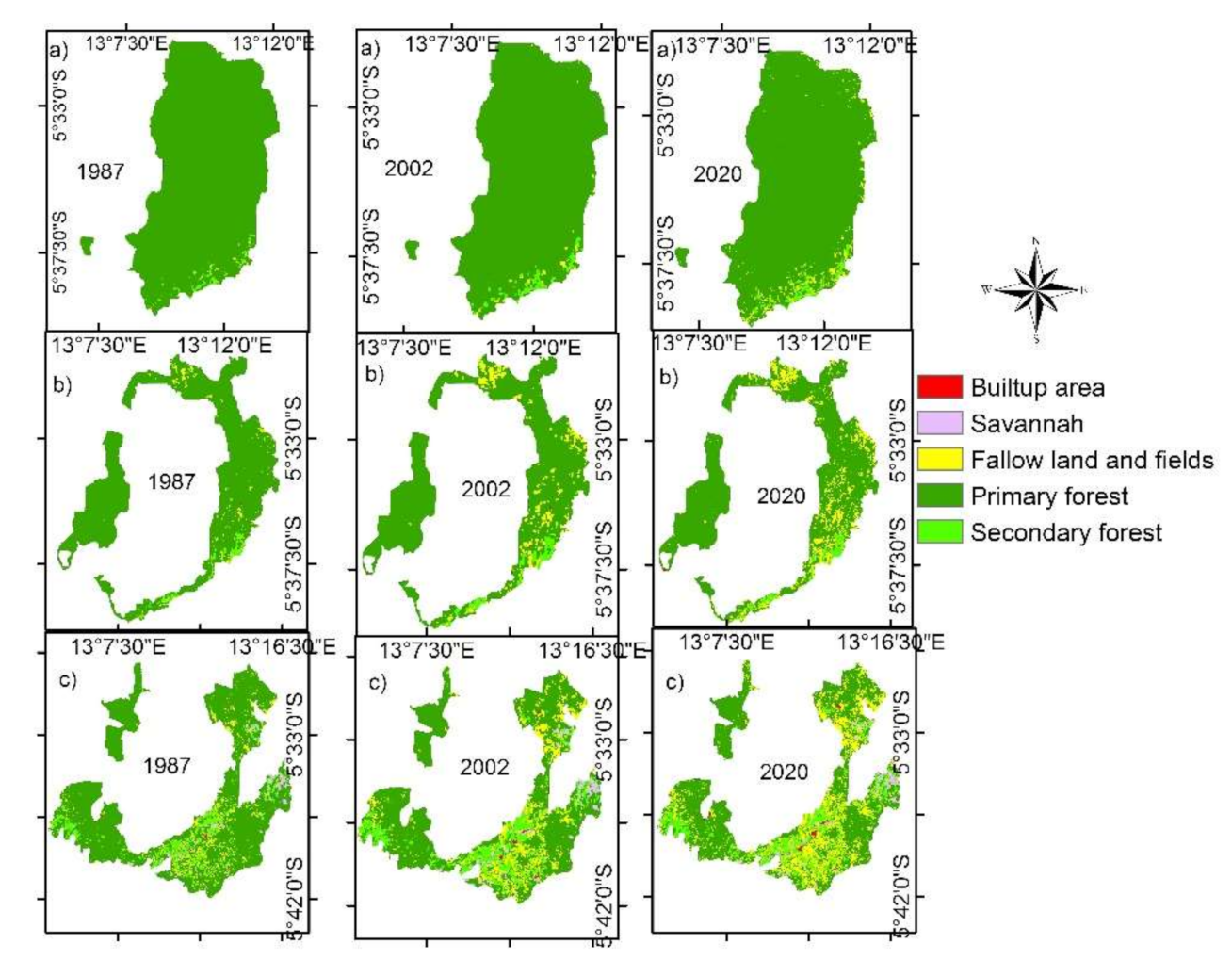
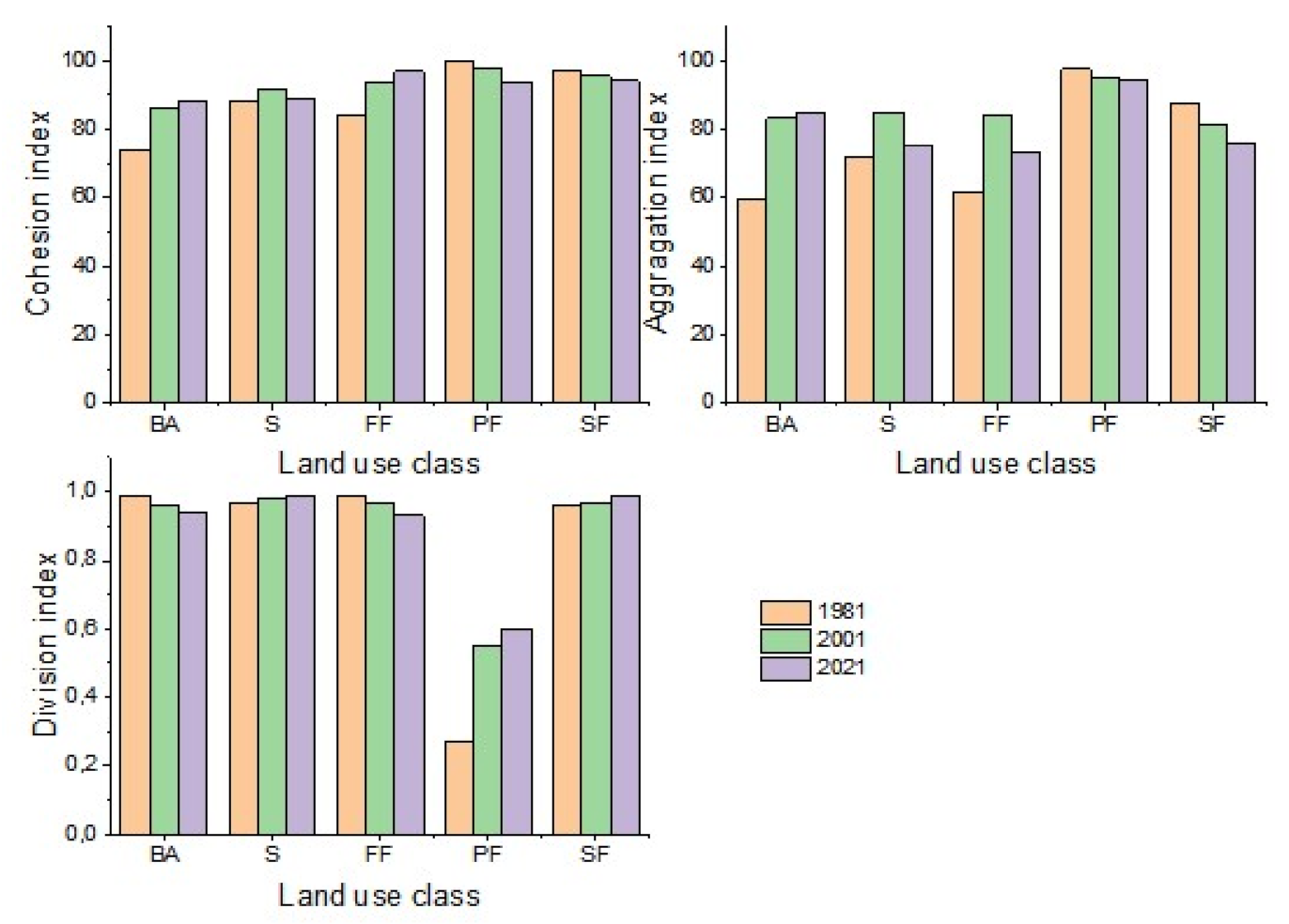
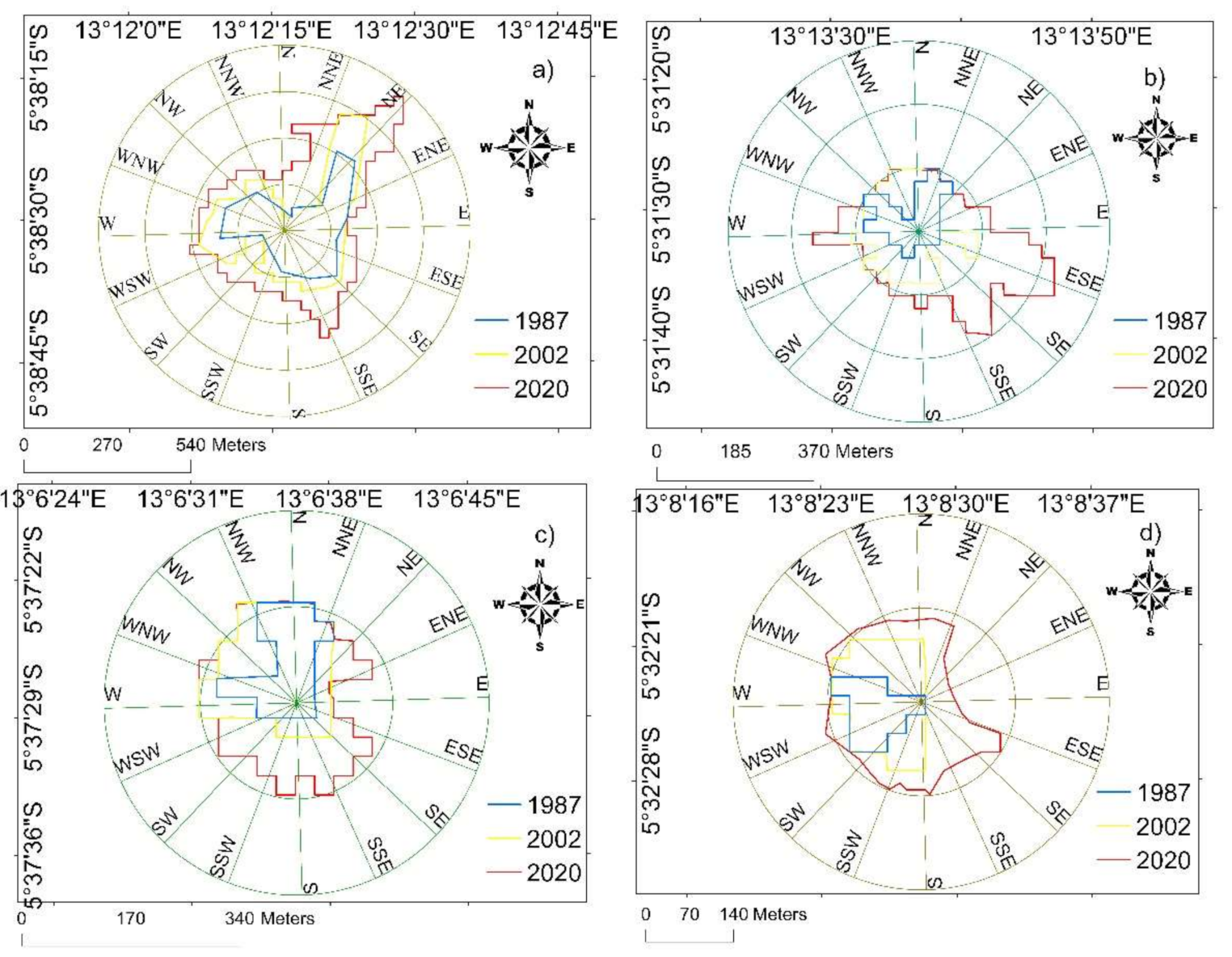
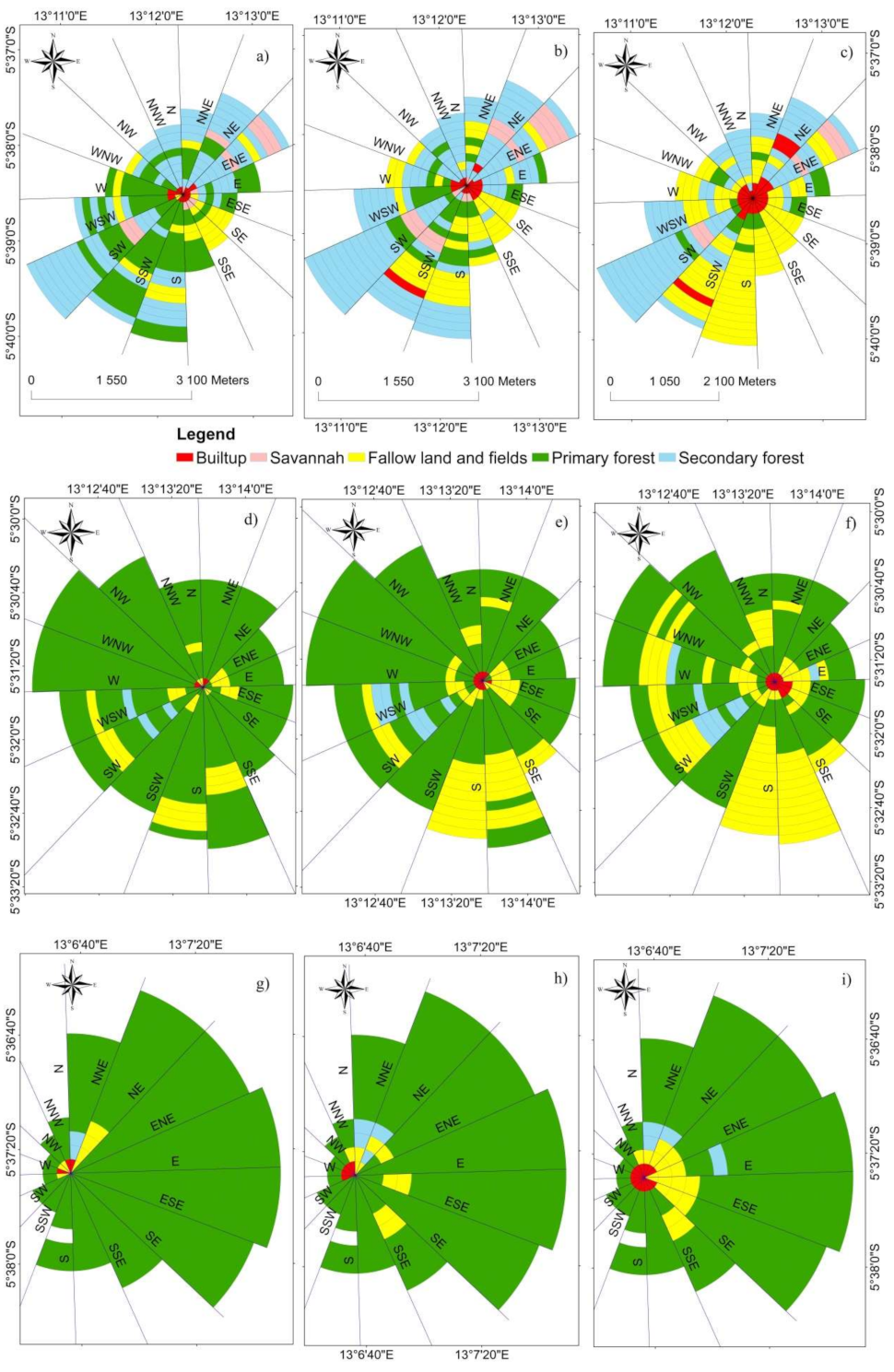
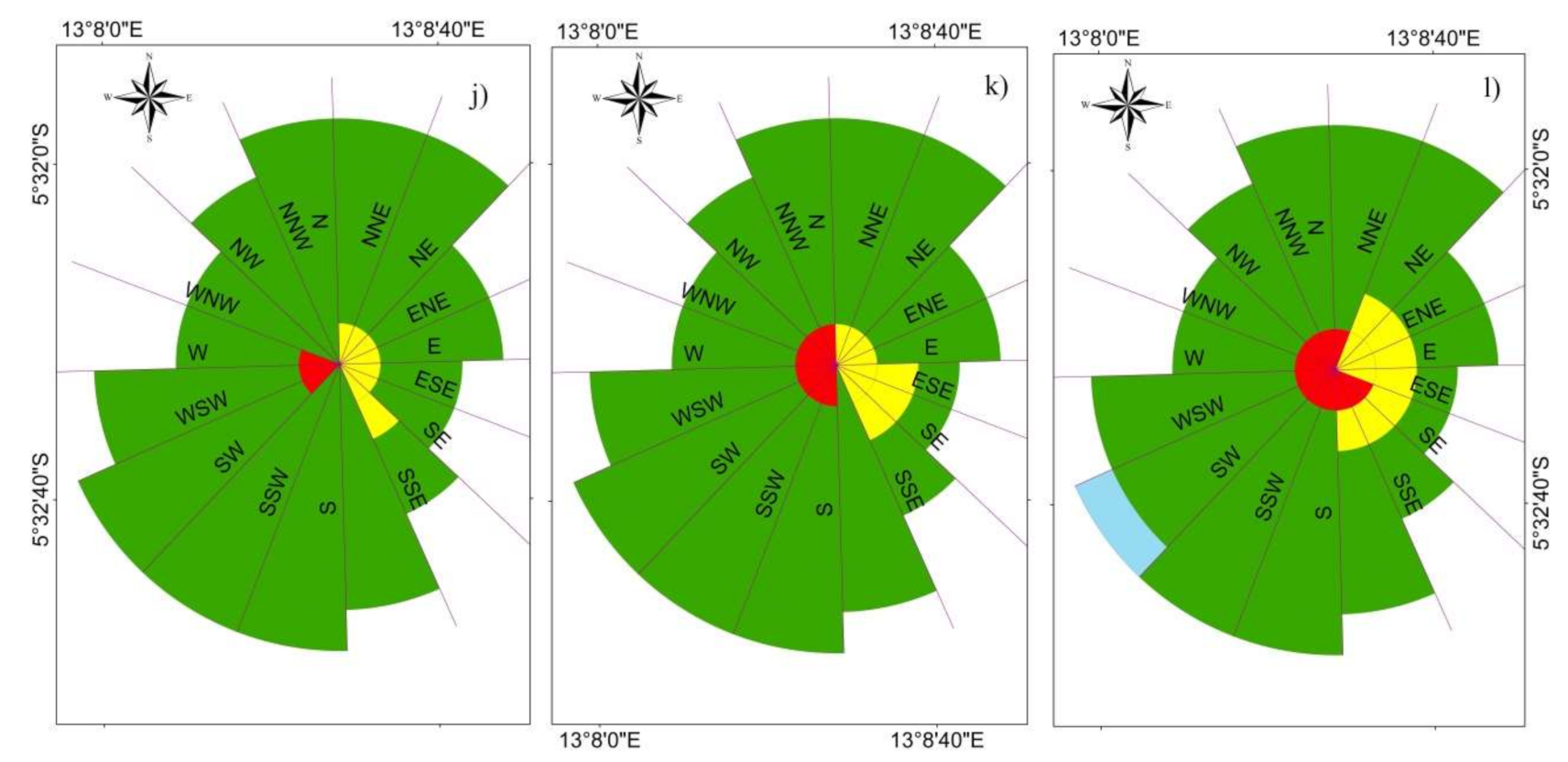
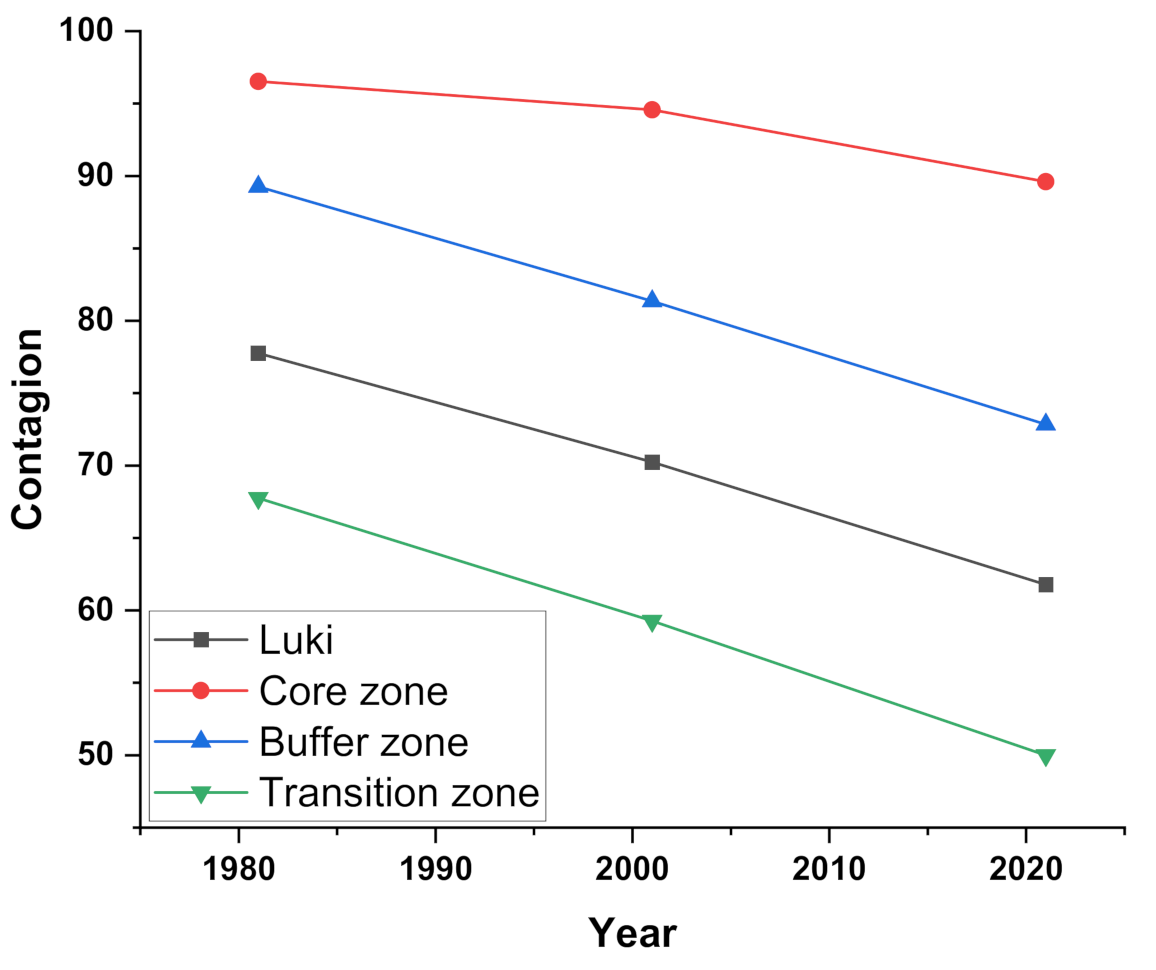
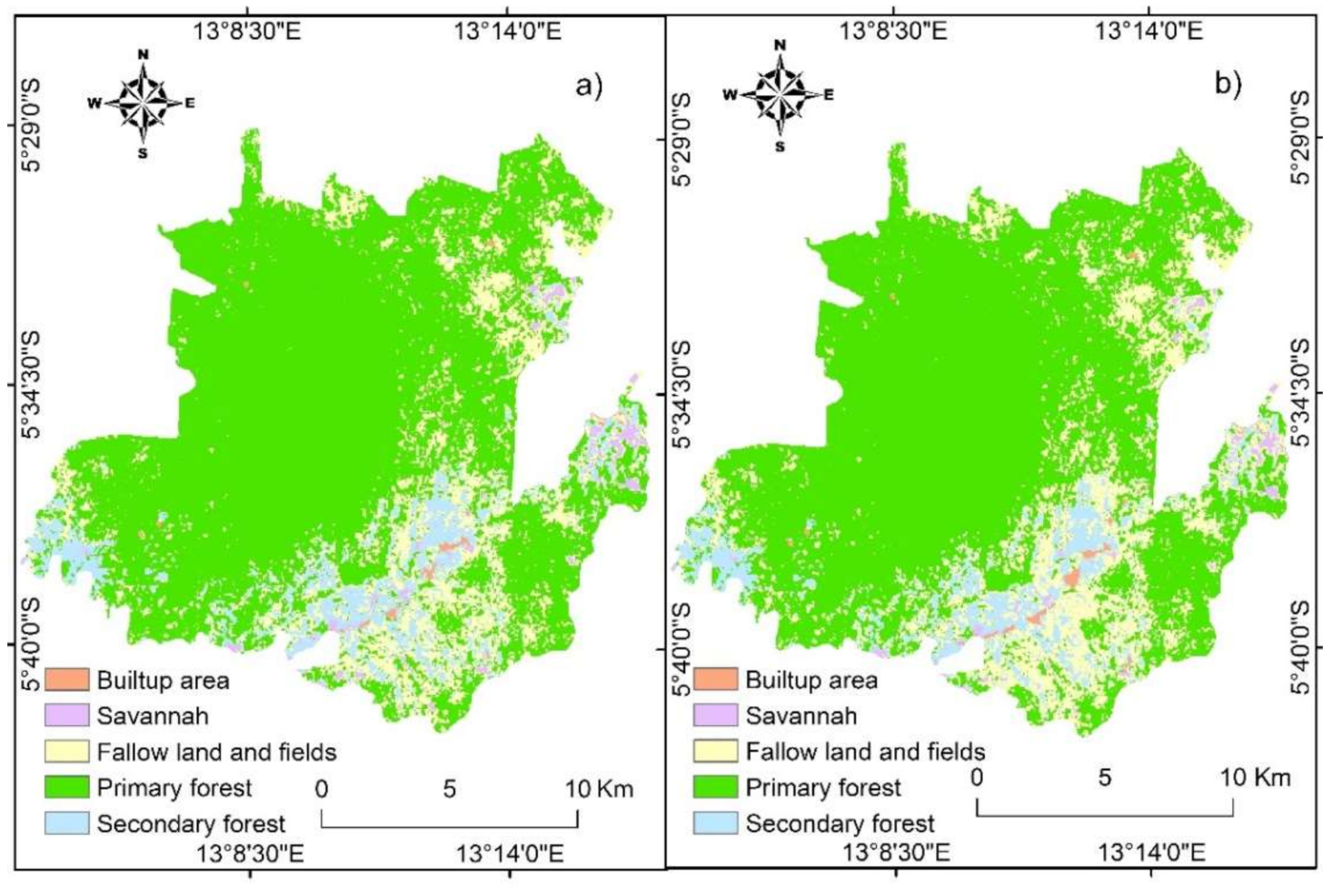
| Data Type | Name | Pixel Size | Wavelength | Description | Year |
|---|---|---|---|---|---|
| Landsat 4 TM | B1 | 30 m | 0.45–0.52 µm | Blue | 1987 |
| B2 | 30 m | 0.52–0.60 µm | Green | ||
| B3 | 30 m | 0.63–0.69 µm | Red | ||
| B4 | 30 m | 0.76–0.90 µm | Near infrared | ||
| B5 | 30 m | 1.55–1.75 µm | Shortwave infrared 1 | ||
| B6 | 30 m | 10.40–12.50 µm | Thermal Infrared 1. | ||
| B7 | 30 m | 2.08–2.35 µm | Shortwave infrared 2 | ||
| Landsat 7 ETM+ | B1 | 30 m | 0.45–0.52 µm | Blue | 2002 |
| B2 | 30 m | 0.52–0.60 µm | Green | ||
| B3 | 30 m | 0.63–0.69 µm | Red | ||
| B4 | 30 m | 0.77–0.90 µm | Near infrared | ||
| B5 | 30 m | 1.55–1.75 µm | Shortwave infrared 1 | ||
| B6 | 30 m | 10.40–12.50 µm | Low-gain Thermal Infrared 1 | ||
| B6 | 30 m | 10.40–12.50 µm | High-gain Thermal Infrared 1 | ||
| B7 | 30 m | 2.08–2.35 µm | Shortwave infrared 2 | ||
| B8 | 15 m | 0.52–0.90 µm | Panchromatic | ||
| Landsat 8 OLI/TIRS | B1 | 30 m | 0.43–0.45 µm | Coastal aerosol | 2017 and 2020 |
| B2 | 30 m | 0.45–0.51 µm | Blue | ||
| B3 | 30 m | 0.53–0.59 µm | Green | ||
| B4 | 30 m | 0.64–0.67 µm | Red | ||
| B5 | 30 m | 0.85–0.88 µm | Near infrared | ||
| B6 | 30 m | 1.57–1.65 µm | Shortwave infrared 1 | ||
| B7 | 30 m | 2.11–2.29 µm | Shortwave infrared 2 | ||
| B8 | 15 m | 0.52–0.90 µm | Band 8 Panchromatic | ||
| B9 | 15 m | 1.36–1.38 µm | Cirrus | ||
| B10 | 30 m | 10.60–11.19 µm | Thermal infrared 1 | ||
| B11 | 30 m | 11.50–12.51 µm | Thermal infrared 2 |
| Explanatory Variable | Cramer’s V | p-Value |
|---|---|---|
| Distance from roads | 0.4097 | 0.0000 |
| Distance from villages | 0.2372 | 0.0000 |
| Distance from farmland | 0.3254 | 0.0000 |
| Slope | 0.1624 | 0.0000 |
| Elevation | 0.3281 | 0.0000 |
| Definition | Description | Reference |
|---|---|---|
| aij = area (m2) of patch ij. A = total landscape area (m2). | [74,75,76] | |
| COHESION = | pij* = perimeter of patch ij in terms of number of cell surfaces. aij* = area of patch ij in terms of number of cells. Z = total number of cells in the landscape. | [77] |
| gii = number of like adjacencies (joins) between pixels of patch type (class) I based on the single-count method. max→gii = maximum number of like adjacencies (joins) between pixels of patch type (class) i based on the single-count method. | [78] | |
| Pi = proportion of the landscape occupied by patch type (class) i. gik = number of adjacencies (joins) between pixels of patch types (classes) i and k based on the double-count method. m = number of patch types (classes) present in the landscape, including the landscape border if present. | [79] |
| LULC Categories | 1987 | 2002 | 2020 | |||
|---|---|---|---|---|---|---|
| Producer’s Accuracy (%) | User’s Accuracy (%) | Producer’s Accuracy (%) | User’s Accuracy (%) | Producer’s Accuracy (%) | User’s Accuracy (%) | |
| Primary forest | 90.7 | 91.9 | 93.9 | 96.3 | 99.05 | 98.05 |
| Savannah | 86.7 | 86.7 | 93.3 | 91.3 | 89.28 | 97.16 |
| Secondary forest | 89.7 | 90.2 | 91.1 | 94.2 | 92.3 | 94.1 |
| Fallow land and fields | 92.3 | 90.6 | 94.7 | 92.3 | 96.19 | 75.75 |
| Built-up area | 90.3 | 90.3 | 91.7 | 91.7 | 98.48 | 66.41 |
| Overall accuracy (%) | 89.16 | 93.6 | 97.17 | |||
| Kappa coefficient | 0.86 | 0.91 | 0.92 | |||
| LULC Categories | 1987 | 2002 | 2020 | |||
|---|---|---|---|---|---|---|
| Area/ha | Area (%) | Area/ha | Area (%) | Area/ha | Area (%) | |
| Primary forest | 28842.2 | 87.59 | 25781.19 | 78.29 | 24030.27 | 72.02 |
| Secondary forest | 1959.2 | 5.95 | 3080.13 | 9.3 | 3129.17 | 9.38 |
| Savannah | 491.1 | 1.49 | 648.75 | 1.97 | 577.58 | 1.73 |
| Fallow land and fields | 1584.5 | 4.81 | 3353.2 | 10.18 | 5505.05 | 16.5 |
| Built-up area | 52.8 | 0.16 | 66.6 | 0.2 | 120.3 | 0.36 |
| Land Use Class | Primary Forest | Secondary Forest | Savannah | Fallow Land | Built-Up Area | |
|---|---|---|---|---|---|---|
| 1987 to 2020 | Primary forest | 82.12 | 4.06 | 0.48 | 13.26 | 0.08 |
| Secondary forest | 0.005 | 90.88 | 0.799 | 7.865 | 0.45 | |
| Savannah | 0.000 | 7.9824 | 83.449 | 1.556 | 7.012 | |
| Fallow land | 0.267 | 7.46 | 0.346 | 91.418 | 0.510 | |
| Built-up area | 0.0000 | 2.555 | 9.000 | 0.852 | 87.5639 | |
| 1987 to 2038 | Primary forest | 80.3971 | 3.1577 | 0.2781 | 16.0690 | 0.0980 |
| Secondary forest | 0.1290 | 73.7975 | 1.0689 | 23.9403 | 1.0643 | |
| Savannah | 0.2220 | 10.6938 | 48.2701 | 29.7132 | 11.1008 | |
| Fallow land | 0.8718 | 11.6752 | 0.5413 | 86.3761 | 0.5356 | |
| Built-up area | 0.3407 | 3.9182 | 5.4514 | 7.1550 | 83.1346 |
| Land Use Category | Area in 1987 | % | Area in 2002 | % | Area in 2020 | % |
|---|---|---|---|---|---|---|
| Fallow land and fields | 33.9 | 0.4 | 58.9 | 0.7 | 228.4 | 2.7 |
| Primary forest | 8488.6 | 98.8 | 8383.23 | 97.6 | 8201.1 | 95.4 |
| Secondary forest | 69.8 | 0.8 | 150.17 | 1.7 | 162.8 | 1.9 |
| Total | 8592.3 | 100 | 8592.3 | 100.0 | 8592.3 | 100.0 |
| Land Use Category | Area in 1987 | % | Area in 2002 | % | Area in 2020 | % |
|---|---|---|---|---|---|---|
| Built-up | 1.8 | 0.03 | 3.87 | 0.06 | 4.59 | 0.07 |
| Savannah | 3.06 | 0.05 | 3.9 | 0.06 | 9.98 | 0.16 |
| Fallow land and fields | 176.88 | 2.78 | 540.62 | 8.5 | 881.61 | 13.88 |
| Primary forest | 6022.74 | 94.8 | 5567.02 | 87.68 | 5203.76 | 81.91 |
| Secondary forest | 148.78 | 2.34 | 237.85 | 3.7 | 253.32 | 3.98 |
| Total | 6353.26 | 100.0 | 6353.26 | 100.0 | 6353.26 | 100.0 |
| Land Use Category | Area in 1987 | % | Area in 2002 | % | Area in 2020 | % |
|---|---|---|---|---|---|---|
| Built-up | 50.45 | 0.3 | 62.5 | 0.35 | 115.28 | 0.64 |
| Savannah | 484.24 | 2.7 | 643.85 | 3.58 | 556.63 | 3.1 |
| Fallow land and fields | 1380.51 | 7.7 | 2765.79 | 15.36 | 4335.14 | 24.1 |
| Primary forest | 14,344.66 | 79.7 | 11,832.81 | 65.73 | 10,304.11 | 57.2 |
| Secondary forest | 1743.26 | 9.7 | 2698.17 | 14.99 | 2691.96 | 14.96 |
| Total | 18,003.12 | 100.0 | 18,003.12 | 100.0 | 18,003.12 | 100.0 |
| Name of Component | Model |
|---|---|
| MLP Markov | |
| Persistence simulated correctly | 95.62% |
| Change simulated correctly | 0.79% |
| Total agreement | 96.40% |
| Change simulated as persistence | 1.91% |
| Persistence simulated as change | 1.66% |
| Change simulated as change to incorrect category | 0.02% |
| Total disagreement | 3.60% |
Publisher’s Note: MDPI stays neutral with regard to jurisdictional claims in published maps and institutional affiliations. |
© 2021 by the authors. Licensee MDPI, Basel, Switzerland. This article is an open access article distributed under the terms and conditions of the Creative Commons Attribution (CC BY) license (https://creativecommons.org/licenses/by/4.0/).
Share and Cite
Michel, O.O.; Ying, Y.; Wenyi, F.; Chen, C.; Kaiko, K.S. Examining Land Use/Land Cover Change and Its Prediction Based on a Multilayer Perceptron Markov Approach in the Luki Biosphere Reserve, Democratic Republic of Congo. Sustainability 2021, 13, 6898. https://doi.org/10.3390/su13126898
Michel OO, Ying Y, Wenyi F, Chen C, Kaiko KS. Examining Land Use/Land Cover Change and Its Prediction Based on a Multilayer Perceptron Markov Approach in the Luki Biosphere Reserve, Democratic Republic of Congo. Sustainability. 2021; 13(12):6898. https://doi.org/10.3390/su13126898
Chicago/Turabian StyleMichel, Opelele Omeno, Yu Ying, Fan Wenyi, Chen Chen, and Kachaka Sudi Kaiko. 2021. "Examining Land Use/Land Cover Change and Its Prediction Based on a Multilayer Perceptron Markov Approach in the Luki Biosphere Reserve, Democratic Republic of Congo" Sustainability 13, no. 12: 6898. https://doi.org/10.3390/su13126898
APA StyleMichel, O. O., Ying, Y., Wenyi, F., Chen, C., & Kaiko, K. S. (2021). Examining Land Use/Land Cover Change and Its Prediction Based on a Multilayer Perceptron Markov Approach in the Luki Biosphere Reserve, Democratic Republic of Congo. Sustainability, 13(12), 6898. https://doi.org/10.3390/su13126898







